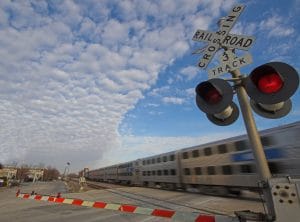BNSF Train Collides With Truck; Kills Metra Passenger
 A fiery crash at the Clarendon Hills Metra stop took the life of a train passenger on Wednesday and injured four others, after a box truck stopped on the tracks during morning rush hour. Reportedly, the truck stalled or became stuck on the tracks as the train approached the Prospect Street crossing.
A fiery crash at the Clarendon Hills Metra stop took the life of a train passenger on Wednesday and injured four others, after a box truck stopped on the tracks during morning rush hour. Reportedly, the truck stalled or became stuck on the tracks as the train approached the Prospect Street crossing.
Although the driver and passengers of the truck were able to escape the vehicle without injury, the conductor of the train was not able to stop before a collision, which caused the truck to explode and burst into flames, with “debris flying everywhere,” according to a witness.
Per ABC 7, “Christina Lopez, 72, was killed and four other people were injured in a crash with a box truck during the Wednesday morning rush hour. She was retired with three daughters, attorneys for her family said Thursday.”
The injured included two BNSF employees and two passengers. “All of us on Metra and BNSF Railway are devastated by this death and we will be working hand-in-hand with the NTSB to find out what happened,” said Metra spokesman Michael Gillis. (FYI, The NTSB is the National Transportation Safety Board.)
As of now it is unclear if charges will be filed against the truck driver or any other parties. Our hearts go out to Ms. Lopez and her family.
How common are railroad accidents in Illinois?
Illinois has a history of railway crossing accidents. In fact, things got so bad in the 1970s that the government started “Operation Lifesaver” to reduce the number of collisions.
And it worked. Per their data, in 1976 (the year the program started) there were “over 900 railroad incidents at public highway-rail crossings and 103 people were killed. In In 2021, there were 124 collisions at highway-rail crossings that resulted in 21 people losing their lives.” Twenty-one lives lost is still too many, but the silver lining is the reduction in these accidents overall, especially considering Illinois “has over 7,300 miles of track with 7,550 public highway-rail crossings and 3,744 private highway-rail crossings.”
The National Safety Council collects statistics regarding railroad accidents, injuries, and fatalities across the country. Per their 2020 data, 757 people were killed in railroad and railway accidents, and non-fatal injuries totaled 5,479. Out of all of these, 684 occurred at railroad crossings.
What are common causes of train accidents?
Although we know Wednesday’s accident happened because of a box truck on the tracks, we don’t know exactly what led to the truck being stuck there in the first place – which is for authorities and experts to investigate. However, train accidents can happen for a variety of reasons:
- Train operator error. This is often a major cause of train accidents. Whether a lack of experience or a mistake on the job, when a conductor makes a mistake, tragedy can occur. Operator error can include driving while drowsy, under the influence, or exercising poor judgement.
- Mechanical failure. Trains are vehicles and machines just like cars and trucks, and they can suffer from defective parts and malfunctions, too. If a signal, switch, or track piece fails, a train can derail or collide with another and cause a massive rail disaster. This can also occur with improper maintenance and repairs.
- Driver or pedestrian negligence. Many railroad crossing accidents are caused by drivers or pedestrians attempting to cross the tracks at the wrong time, or when a vehicle stalls or becomes stuck on the tracks. A train may not see a vehicle or person and be unable to stop in time.
- Speeding. Trains traveling too fast for conditions can derail, causing mass tragedies. Additionally, if a speeding train collides with an object or person, the results can be devastating.
- Improperly marked crossings. Poorly protected or maintained crossings can result in railroad crossing accidents. Rail crossings must have warnings like gates or lights. When these are absent or malfunction, drivers can miss them and collide with a train.
What should I do if I was involved in a Chicago train accident?
If you are in a train or rail accident, the first thing you should do is follow all alerts and instructions from workers and emergency first responders to get yourself and others to safety. Then, your first priority should be seeking medical attention for your injuries.
If you are able to do so safely, take photos of the accident scene as well as your injuries. Get the contact information of any witnesses. Afterward, see your physician even if you don’t feel injured. Some injuries may take a while to appear, and a doctor can diagnose serious or internal injuries before they become life-threatening. Keep a record of any days you miss from work, as well as a record of medical expenses and documentation.
It’s also important to consult with an experienced train accident attorney. Whether you were a passenger on a train or on the railway tracks when involved in a railroad accident, if you were injured through no fault of your own, you need experienced and strategic representation. Injuries resulting from train accidents are often catastrophic or fatal, and the Chicago legal team at Gainsberg Injury and Accident Lawyers understand how to handle these complex cases. We can help file a personal injury or wrongful death claim on your behalf.
If you or a loved one were seriously injured in a train or railway accident, the Chicago injury attorneys at Gainsberg Injury and Accident Lawyers want to help. We have the resources, expertise, and skill to investigate and handle your injury claim. We understand the elements of a personal injury or wrongful death claim and the elements necessary for a successful outcome. To schedule an appointment to discuss your case with an experienced member of our team, call 312-600-9585 or submit our contact form today.

Attorney Neal Gainsberg has spent the last 20+ years fighting to protect the rights of the injured in Chicago and throughout Illinois. For dedicated legal help with a personal injury, car accident, or wrongful death matter, contact Gainsberg Injury and Accident Lawyers in Chicago for a free consultation.
